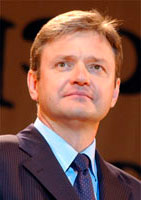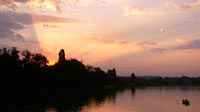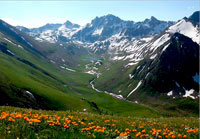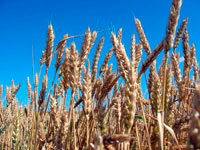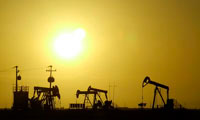-
The business of Kuban
The website you are now looking is a portrait of the business Kuban. There has something in common the history and the contemporaneity, the past we are proud of and the present that we cherish.
A lot of centuries back Kuban charmed European travelers. Greeks and Scythians, Meots and Khazars, Genoese’s and Half-sheep’s battled for the right of possession of these lands. And only brave proud Cossacks finished this centuries-old dispute two centuries ago. We hope this website will help you to learn, understand Kuban better and be fascinated by it — by the Earth where the expanses of the steppes run away for the horizon where two seas — Black and Azov — merge in eternal embraces, where people live amazing with their unusual kindliness, hospitality and talent.
The Krasnodar territory
Kuban is the name of Krasnodar Territory, one of 89 subjects of the Russian Federation, occupying just 0.44% of the All-Russian space — 78 thousand sq. km., but having much greater significance for its geographical position and the vicinity to two most southern seas — the Black sea and the Azov sea, for developed sanitary and resort and also tourist infrastructures, transportation network and availability of the favorable natural conditions.
The Territory possesses the signifi-cant natural and resource potential, has available international airports, developed network of the highways and railroads. Krasnodar Territory, having the direct access to the sea ways, realizes the interests of Russia in the Black Sea and Mediterranean zones of economic cooperation. Krasnodar Territory neighbors with Rostov Region in the north and in the northeast, with Stavropol Territory and Karachai-Circassian Republic in the east and in the south-east and with Georgia in the south. In the west, south-west and in the south the Territory is washed by the waters of the Black sea and Azov seas. The length of the borderlines makes 14,540 km, including 800 km running overland and 740 km — over the sea. The most northern point is 372 km far from the most southern one and the most western point is 380 km far from the most eastern one.
Krasnodar Territory is a region of Russia and is approximately midway between the equator and the North Pole, lying in the latitude of the North Italy and South France.
The Kuban plain is bedded on the ancient Scythian plate, that is of about two kilometers in thickness. The climate in the plain part of the Territory is moderately warm with hot summer and mild winter. On the Black Sea coast the climate is transitional to subtropical (from Anapa to Tuapse) and subtropical (from Tuapse to Adler). The average temperature of January ranges from +4, +5 °C, in the area of Anapa down to −8 °C in the mountains on the 2000 m elevation; temperature of July — +22, +24 °C on the plain and +12, +13 °C in the mountainous terrain. Summer lasts 4–5 months, in autumn and in winter the weather is warm.
The soil of the Territory is represented by the fat, fertile chernozems in the northern steppe right-bank and southern left-bank highland belts and also along all the lower flow of the Kuban river and in the foothills. The Kuban chernozems, amounting to more than 120 cm of humus layer in depth, are among the primary riches of the Territory and Russia. The fluvial system of Krasnodar Territory incorporates the Azov and Kuban lowlands, the Kuban river and its affluence and also the Black Sea area basin. It numbers more than 13 thousand rivers, rivulets and streams.
The Kuban river — the main waterway of the Territory — runs 870 km and divides the region into the northern steppe right-bank, southern left-bank highland parts. The rivers of the Black Sea area feature the large slopes and often look like the mountain streams.
The lakes always engaged everyone to themselves by inimitable beauty, clean air, silence and quiet, reigning on their shores. The lakes are disposed in Krasnodar Territory both along the coasts of the Azov and Black Sea (Khanskoye, Golubitskoye, Solenoye, Chemburka) and in the valleys of the steppe rivers. The mountainous lakes deserve to lay special emphasis on those.
The largest sweet-water lake in Krasnodar Territory is the Abrau lake, located at an elevation of 84 km, its surface area is of 1.6 sq. km. The alpine Kardyvach lake, surrounded by the rock bulwarks of 3-kilometre heights is believed to be the champion of beauty. The dwarf lakes — Khyzhi (sacred one for Adygei people, Tuapse district), Verkhneafipski Lochnessi (Severski district) and Mertvoye (Goriachy Kliuch) and many others are fraught with much undiscovered.
The largest in Europe Azov and Kuban basin of underground sweet waters is located in Krasnodar Territory. More than 60 kinds of mineral resources, occurring basically in the piedmont and mountainous districts, were discovered in earth’s womb of Kuban. Krasnodar Territory is rich with the deposits of marble, marl, sandstone, gravel, arenaceous quartz, as well as with the reserves of oil, natural gas, iodide-bromine and healing mineral waters.
More than 200 therapeutically valuable mineral sources were discovered in the different districts of the Territory. The warm seas and healing climate, the unique natural mineral sources and curative muds brought to Kuban the fame of one of the most popular resort and tourist regions of Russia.
The Matsesta sources, curing the diseases of joints, respiratory organs, skin and nervous disorders are genuinely world-famous. The sulfurated hydrogen waters of Goriachy Kliuch are efficient against the diseases of gastrointestinal tract and rheumatism. In Yeisk they treat the diseases of joints and radiculitis. The sources of Zaporozhie are similar to «Yessentuki» waters by composition. The deserved glory has been reaped by the Semigorski sources, that are found close to Anapa. The forest is of great environmental significance and appears to be the primary source of finewood. The area of Krasnodar Territory forests totals more than 18 million ha. The commercial oak and beech woodlands occupy 68% of the all forests surface, where also horn-beam, chestnut, fir, spruce and the fruit trees such as pear, apple and cherry plum are represented.
The zone stretching from Tuapse to Adler along the Black Sea coast is subtropical. Here the citrus plants — mandarins and oranges — grow; and tea plantations spread.
The mountainous terrain of Krasnodar Territory numbers 64 glaciers. Almost all of them are disposed on the Main Caucasian Ridge and on its northern shoots. The slopes of Pseashkho mountainous massif hold the largest glacier Kholodny (Cold), and the most western one in all the Caucasus nestles down on the slopes of the Fisht mountain.
The animal world of Krasnodar Territory is rich and diversified. All in all, 86 species of mammals, 3200 — of birds, 163 — of fishes, 21 — of reptiles and 11 — of amphibia can be counted. Among these many are registered in the Red Book of the Russian Federation and Kuban. The vast areas are occupied by the wildlife sanctuaries and national parks. The forests are inhabited predominantly by the deers, bears, chamoises, Caucasian goats, Eurasian pigs and other mammals, the Azov sea plavs are the kingdom of the birds — pelicans, waders, ducks and swans.
Not a single region of Russia can equal Kuban by the level of viniculture and vinification. The cultivation of grapes is a business of 51 farms, and 34 ones are engaged in grapes processing and output of the wine products, famous outside of Krasnodar Territory and Russia.
Krasnodar Territory was formed on September 13, 1937 and is incorporated into the South Federal District of the Russian Federation. The seat of Krasnodar Territory administration is the city of Krasnodar. Krasnodar is 1539 km far from Moscow.
Krasnodar Territory is of 38 districts, 15 cities of the Territory subordination, 11 towns of the district subordination, 11 local regions, 21 townships, 390 rural administrations, 1719 rural settlements. The largest cities of Kuban are Krasnodar, Sochi, Novorossiysk, Armavir, Yeisk, Gelendzhik, Kropotkin. Krasnodar is the administrative, economic and cultural centre of Krasnodar Territory. Krasnodar Territory ranks third among the subjects of the Russian Federation in the number of population: here 3.5% of the Russia’s population lives. The density of population amounts to 66 persons per square metre, and it is 8 times as large as the average Russian figure.
Krasnodar Territory is inhabited by 5 million 124 thousand persons, including 2 million 739 thousand in the cities, towns and townships and 2 million 384 thousand persons in the countryside. The inhabitants of the Territory centre number more than 790 thousand or 15% of the Territory population. The population of Krasnodar Territory is represented by more than 100 nationalities. The bulk of population is constituted by the Russians (86.1%). The Armenians account for 4.9% of the total Kuban dwellers number, Ukrainians — 3.9%; Belorussians — 0.7%; Adygeis— 0.6%; Greeks — 0.4%; other nationalities — 3.4%.
The recent years saw the decrease in population of the Territory, as well as in Russia as a whole. But the share of the ablebodied population increased from 56% to 57.5% for the last three years. The labour resources of the Territory number about 3 million persons (or almost 60% of the total population) on the annual average, and the total population engaged in economy exceeds 2 million persons.
In the last years the situation in labour market is stable. It is characterized by:
- the growth of labour force engaged in economic activity, basically due to increase in the number of those engaged in private sector;
- the persistent decrease in total and registered unemployment.
Over 14 thousand were placed in job, as they finished the course of professional training, arranged by the placement services. All in all, such education in trades, having demand on the labour market, was completed by almost 22 thousand people, and the services of professional orientation were rendered to 172 thousand people.
The emphasis is placed on employment of the socially ill-protected citizens. As the law of Krasnodar Territory makes provision, the allocation of the workplaces is carried out for the persons, standing in dramatic need of social protection and suffering the hardships, searching for a job.
Krasnodar Territory is one of the most important economic regions of the Russian Federation. Kuban ranks in top twenty among 89 regions of the country by the level of the social and economic development and in top ten— by the volume of the gross regional product.
The social and economic development of the Territory was defined to large extent in the recent years by the All-Russian tendencies that became evident after the crisis if 1998, as well as by the tax, budget and social policy, pursued at the federal level and by the institutional transformations.
The last years saw economy of Krasnodar Territory to achieve the steady rate of development. Beginning from 1997 the rates of decline slowed down in many branches of economic complex of Kuban. Over the period of
The production share of the Territory gross regional product in the All-Russian volume of gross domestic product stabilized at 2.1% level.
The positive growth dynamics of the Territory gross regional product was provided at the cost of enlarged volumes of products and services output in the primary branches of economy at 1.4- to
During the continuance of the last years the economy of Krasnodar Territory has become more and more open. The liberalization of foreign trade in the early nineties favored the active development of Krasnodar Territory’s trade relations with the foreign countries.
Krasnodar Territory is in the forefront of the external economic activity in the south of Russia.
The high level of the world market prices for crude oil and oil products provided the considerable rates of the regional export growth, and the decrease in domestic demand for imported foodstuffs — the decline in the volumes of foodstuffs and agricultural raw material purchases.
The foreign trade turnover of the Territory shows an increase from year to year. The trade pattern of the Territory’s export is dominated by crude oil and oil products (over 70%). The articles of exportation also comprise the grain crops and oil-bearing seeds, timberwood and woodworking products, mineral fertilizers, turning lathes and metalcutters and many others.
The dynamics of the total goods import volume is characterized by the minor variations, but its structure has significantly changed in the last years. The steady tendency is exhibited to increase in the purchases of producer goods (machinery and equipment, transfer mechanisms, ferrous metals), followed by the concurrent decrease in the share of the foodstuffs import. The leading partners of the Territory are the countries as follows: the United States of America, Germany, Italy, Turkey, Ukraine, Uzbekistan and Belorussia. The geography of foreign trade is characterized in the last years by the greater proportion of trade with the non-CIS countries.
The foreign trade turnover of the services grows at a rapid pace. The structure of the services export is dominated by the transport services and the structure of the services import — by construction services and business services: predominantly by consulting services on the issues of management and the services in the field of research and developments.
The. stabilization and economic revival, beginning to show in the last years, determined the appreciable improvement of the quality of life. The real money incomes and actual earnings of population have regained the positive dynamics.
The legislation of the Territory shows good improvement. The legislative and normative acts of Krasnodar Territory were adopted to enable the processes of the social and economic stabilization become more active. The management structure and controlling mechanism have been brought to perfection in different industries. It is small business that has become a noticeable and significant sector of economy: in the South Federal District it ranks first and second in the volume of the output products and in the number of operating plants respectively. Such approaches make the basis for the steady economic growth in succeeding years.
